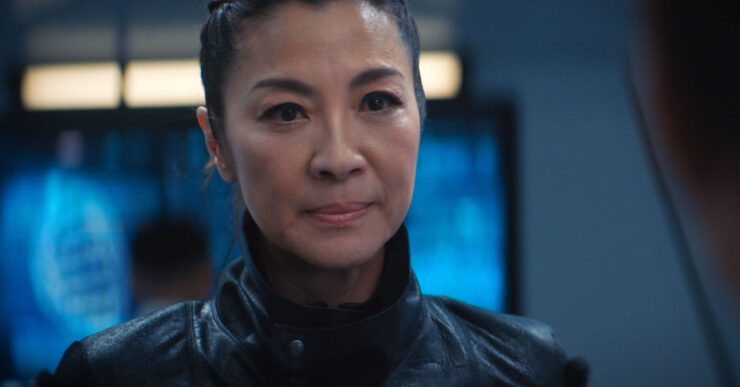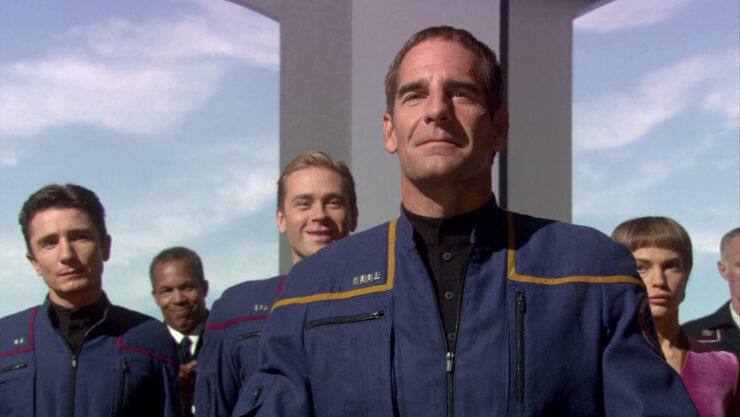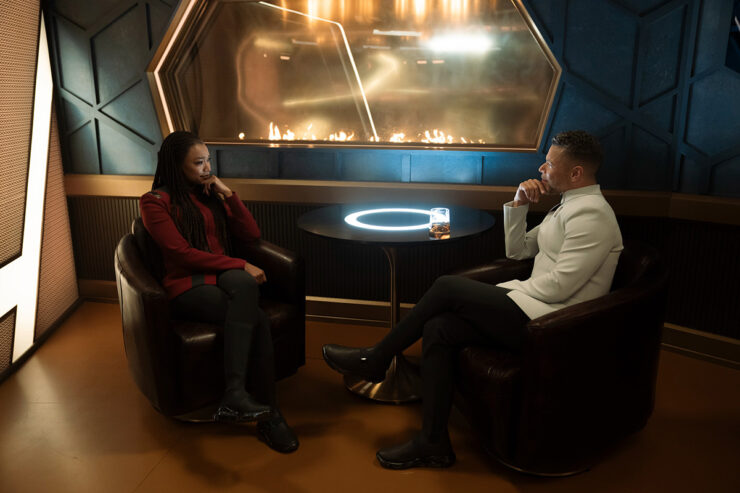When I was a kid, I was a big fan of The X-Files. It was the ’90s, politics were a thing for the Royal Canadian Air Farce (basically, Canada’s SNL) to make fun of, and vague yet sinister conspiracies perpetrated by shadowy bureaucracies of black-clad spooks were all the rage. And so, when the producers of Deep Space Nine opted to uncork a little of that X-Files magic in the Star Trek universe in the sixth season episode “Inquisition,” I was over the moon about it.
Section 31! What a concept! A rogue government agency so secret that even the well-informed Constable Odo had never heard of it, so ancient that it had been working behind the scenes in Starfleet since the beginning, and so utterly ruthless that it would engineer a plague against the Changelings to keep the Federation safe! Its very name was redolent of the “Area 51” of UFO lore, its agents sporting sexy black leather jackets that fastened on one side. Its main representative—the mysterious figure known as “Sloan” (ably played by William Sadler)—was the very model of the enigmatic G-man, raspy of voice and chiselled of feature. Its motivations were best described by the boilerplate on a limited series of tie-in novels released after Deep Space Nine ended:
They are the self-appointed protectors of the Federation. Amoral, shrouded in secrecy, answerable to no one, Section 31 is the mysterious covert operations division of Starfleet, a rogue shadow group committed to safeguarding the Federation at any cost.
No Law.
No Conscience.
No Stopping Them.
Now I ask you: doesn’t that all just sound so…cool?
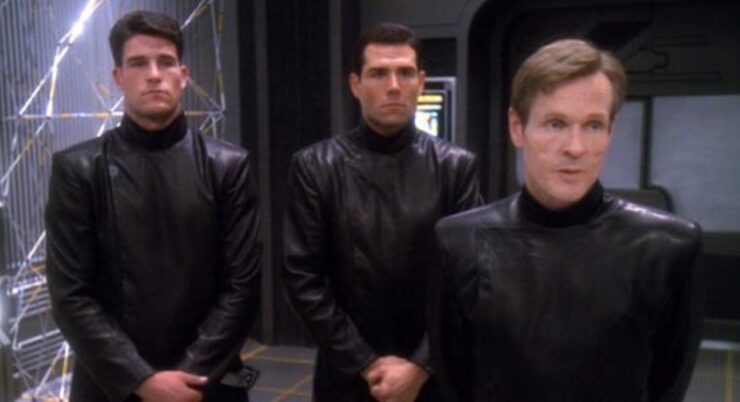
Of course, in my adolescent exuberance, there were a few questions that I neglected to ask at the time. Questions like: How do you keep a massive conspiracy like this running for more than two centuries—in a Federation that includes several telepathic races, no less—without anyone letting on about it? Or: If they’re supposed to be so secret, how come they go around in extremely conspicuous black leather jackets that might as well have the word “VILLAIN” emblazoned across their backs in beadwork? Or the big one: Doesn’t the existence of a genocidal black ops group that has operated at the heart of the Federation all along kind of negate the entire utopian premise of the franchise?
That last question was, of course, the whole point of Section 31. One of showrunner Ira Steven Behr’s mission statements for Deep Space Nine as a series was to “dig deeper and find out what, indeed, life is like in the twenty-fourth century. Is it this paradise, or are there, as Harold Pinter said, ‘Weasels under the coffee table’?”
For the most part, I would say that Deep Space Nine did a good job of showing off the Federation’s “weasels”: the situation in “The Maquis,” for example, only arises because it turns out that the Federation’s metropole—Earth—is seemingly indifferent to the concerns of its colonists; “Hard Time” and “The Siege of AR-558” reveal that, under prolonged stress and deprivation, even our “more evolved” Starfleet heroes can regress to the level of murderous barbarians; and the “root beer” conversation between Quark and Garak in “The Way of the Warrior” is still one of my all-time favourite Star Trek moments. I must admit, however, that Section 31 is a rather miserable specimen of the weasel species.
In all of the other cases that I have named above—and, indeed, in a few other cases that I could name—Deep Space Nine was effectively engaging in deconstruction. Now, this is a word that is thrown around a lot in fandom circles, oft times inappropriately, but I am using it here in the specific, critical sense of foregrounding the implicit contradictions in a work of fiction—in this case, the rest of the Star Trek franchise, especially The Next Generation. What does it mean, for example, that our utopian, humanistic, post-scarcity society is so heavily grounded in imperialist American “frontier” mythology and largely set on board what amount to Royal Navy research vessels at the height of Pax Britannica? This is the type of question that Deep Space Nine did a good job of unpacking. But there is a very important difference between finding a weasel under someone’s table and releasing one in their living room, and Section 31 is, in my opinion, very much an example of the latter. There’s no precedent for it in the franchise; nothing that its backstory is needed to unpack or explain. Indeed, it makes the whole thing more inexplicable: societies with unchecked, unaccountable black ops and secret police forces do not, typically, resemble paradises even on a surface level—something that DS9 itself readily understood when it came to worldbuilding for the Cardassians. Section 31, then, is just there, seemingly so that you can point to it and say “Ha! You call this a utopia? It has weasels in it!”
But one can, perhaps, forgive DS9 this particular indulgence; it came in the midst of a larger arc about what happens when you throw Gene Roddenberry’s humanist utopia into a major war, and it can be read in the context of that story: To what extent is the Federation willing to sacrifice its morals to ensure its own survival? One can even write-off the claim that Section 31 has always existed: Sloan is hardly a reliable source, and there’s no corroborating evidence. Most importantly, though, is the fact that DS9 never presents Section 31 as anything other than a criminal conspiracy; we’re not meant to accept Sloan’s ends-justify-the-means ideology, and in fact the war ends with its repudiation: Bashir steals the cure to the Changeling plague from Sloan’s brain and Odo delivers it to the Changelings, saving billions of other people’s lives in the process.
And yet I do wish that DS9 had put its weasels away once it was done with them! Instead, they were allowed to escape into the basement of the franchise and breed down there.
The first evidence of a genuine weasel infestation was seen six years after DS9 ended, during the final season of Enterprise. Section 31 doesn’t actually do very much here, honestly: They get mixed up in the whole Klingon Forehead Controversy (mostly on the side of screwing up and making things worse) and later give the Enterprise crew some critical intelligence that helps them defeat the terrorist group Terra Prime (which they probably could have gotten just as easily somewhere else). There’s the usual back and forth about whether the ends justify the means (with our heroes very much on the “no” side), but it feels weirdly perfunctory. What it does accomplish, however, is to prove that Sloan was not lying back on DS9—
there really has been a criminal conspiracy at the heart of Starfleet since the very beginning.
With this fact cheerfully established, the gates were opened for a veritable flood of weasels into contemporary Star Trek. The film Star Trek Into Darkness (2013) introduces Section 31 to the Kelvin Timeline as the architects of a plot to militarize Starfleet for war with the Klingons. Much though I may personally dislike this movie, it is to its credit that it never depicts the organization as anything other than a bunch of villains who need to be defeated; and, furthering Enterprise’s characterization, it also makes them out to be bungling buffoons releasing forces beyond their control—in this case, Khan Noonien Singh (Benedict Cumberbatch) on a head-squishing kick.
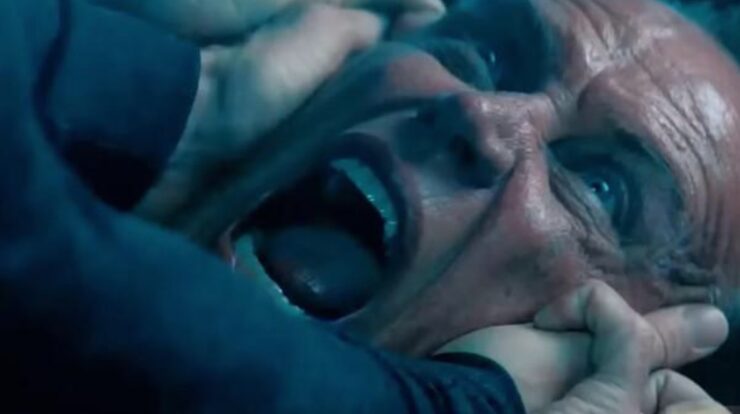
It’s only in the second season of Discovery that we start to blur the line between criminality and legitimacy for Section 31. Here again, the organization presents its now-standard mix of bloody-minded villainy and complete incompetence, but there’s a difference: This time, Section 31, rather than being a dirty secret, is retconned into a legitimate intelligence agency; indeed, their representative, Ash Tyler (Shazad Latif), gets to throw his weight around on Discovery’s bridge almost in the manner of a political officer. They even have their own ships—they’re sleek, and black, and cool-looking. Captain Pike is still very much opposed to their methods, but he’s shot down by Admiral Cornwell. At the end of the season, after Section 31 very nearly gets every living thing in the galaxy killed through sheer stupidity, a faceless Starfleet bureaucrat (Thom Marriott) concedes that the organization needs “a radical overhaul—and perhaps more transparency.” Yes, perhaps!
Which brings us, inexorably, to Picard season three. Here, Section 31—although mostly offscreen—is as evil as it’s ever been depicted: We learn that not only did they engineer a bioweapon for use against the Changelings back during the Dominion War, but they also performed torturous medical experiments on Changeling prisoners of war. The revelations presented are truly heinous—even difficult to watch—and the entire season-long arc largely results from blowback against Section 31’s crimes against sentient life. And yet… the story pairs these revelations not only with complete legitimation of 31 as an organization, but complete acceptance of its crimes on the parts of our ostensible heroes. Worf—you know, the honourable guy? Whose friend, Odo, was deliberately infected with a plague by Section 31 with the intent of using him to wipe out his entire race? That Worf?—even calls them a “critical division of Starfleet Intelligence.” There’s one glorious moment where Picard actually looks sick upon hearing the extent of Section 31’s crimes; but then—arguably in the face of thirty-five years of consistent characterization—he and Dr. Crusher opt to compound them by executing a prisoner of war. This is never mentioned again. Just another day at the office, I suppose. We have, as an official, critical division of our humanist utopia of Starfleet, an organization that openly commits war crimes… and it’s just become part of the setting. It’s not even presented as a reason for Jack not to join Starfleet. One wonders if it was mentioned in the recruitment materials they gave out to the kids on Prodigy.
Buy the Book
Dead Country
There is, of course, a darker side to this merry jaunt through the last quarter century of Star Trek canon; namely, that it directly parallels the real-life growth of the national security state (that alphabet soup of government organizations charged with “ensuring public safety”), particularly in the decades following 9/11.
Looking at some of these bodies, it is remarkable how recently they were established: The U.S. Department of Homeland Security, U.S. Immigration and Customs Enforcement, and the U.S. Transportation Security Agency all date to after the turn of millennium. Like our fictional Section 31, these organizations are regularly accused of lawlessness, indifference to civil rights, and horrifying human rights abuses; like Section 31, they have become part of the wallpaper of daily existence: normal; natural; a part of the setting, as it were. Indeed, even in imaginary, far-future utopias where people can travel at thousands of times the speed of light and synthesize any material good out of raw atoms, the idea of living without such organizations is now apparently too radical to seriously entertain—even when they are canonically heinous, ridiculously incompetent, and prone to making life worse for everyone.
As the reader may have discerned from the general tenor of this essay, I am… less than enthusiastic about Paramount+’s long-promised and now-apparently-underway Michelle Yeoh-led Star Trek: Section 31 project. However, hope—particularly in the Star Trek universe—springs eternal, so I would like to conclude this essay by describing what I would like to see in this film. When we last saw Yeoh’s Emperor Georgiou in Discovery’s “Terra Firma, Part 2,” she had turned a new leaf; a quick trip back to her native Mirror Universe had convinced her that the selfish and martial virtues with which she had grown up in the Terran Empire were actually kinda terrible, and she’d vowed to take this lesson with her as she leapt through the Guardian of Forever, returning to an unspecified date back in time. What I would like is for her to make good on this epiphany and to have a proper redemption arc. Emerging in the era immediately after Picard season three, I would like to see her go on a one-woman crusade to systematically demolish Section 31 once and for all.
After all: even if you have weasels under your coffee table, you can always call-up animal control.
Jaime Babb is a writer and PhD candidate in Science and Technology Studies currently living in Toronto. She can be followed on Tumblr at quasi-normalcy.tumblr.com.










